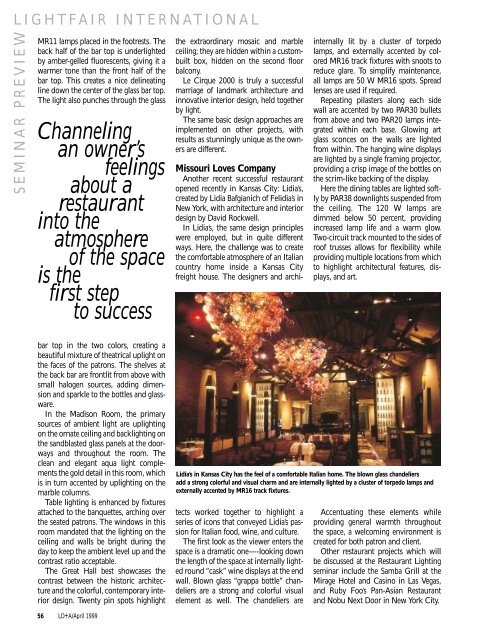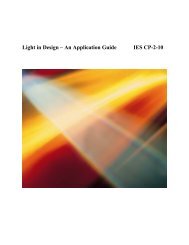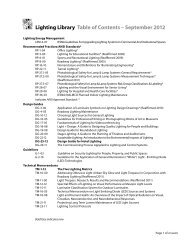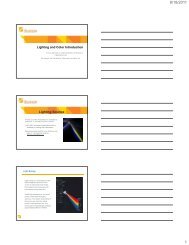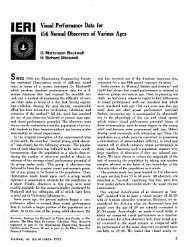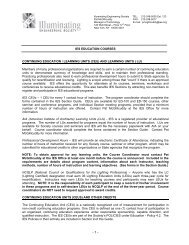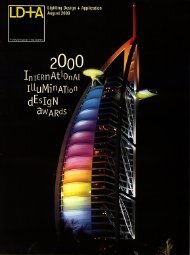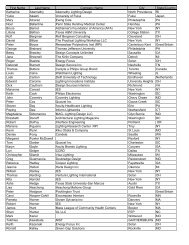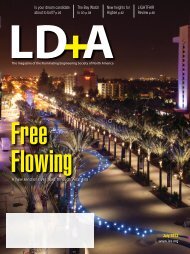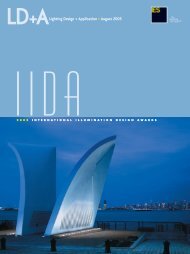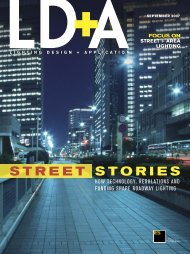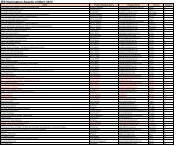lightfair international - Illuminating Engineering Society
lightfair international - Illuminating Engineering Society
lightfair international - Illuminating Engineering Society
You also want an ePaper? Increase the reach of your titles
YUMPU automatically turns print PDFs into web optimized ePapers that Google loves.
LIGHTFAIR INTERNATIONAL<br />
SEMINAR PREVIEW<br />
MR11 lamps placed in the footrests. The<br />
back half of the bar top is underlighted<br />
by amber-gelled fluorescents, giving it a<br />
warmer tone than the front half of the<br />
bar top. This creates a nice delineating<br />
line down the center of the glass bar top.<br />
The light also punches through the glass<br />
Channeling<br />
an owner’s<br />
feelings<br />
about a<br />
restaurant<br />
into the<br />
atmosphere<br />
of the space<br />
is the<br />
first step<br />
to success<br />
the extraordinary mosaic and marble<br />
ceiling; they are hidden within a custombuilt<br />
box, hidden on the second floor<br />
balcony.<br />
Le Cirque 2000 is truly a successful<br />
marriage of landmark architecture and<br />
innovative interior design, held together<br />
by light.<br />
The same basic design approaches are<br />
implemented on other projects, with<br />
results as stunningly unique as the owners<br />
are different.<br />
Missouri Loves Company<br />
Another recent successful restaurant<br />
opened recently in Kansas City: Lidia’s,<br />
created by Lidia Bafgianich of Felidia’s in<br />
New York, with architecture and interior<br />
design by David Rockwell.<br />
In Lidia’s, the same design principles<br />
were employed, but in quite different<br />
ways. Here, the challenge was to create<br />
the comfortable atmosphere of an Italian<br />
country home inside a Kansas City<br />
freight house. The designers and archi-<br />
internally lit by a cluster of torpedo<br />
lamps, and externally accented by colored<br />
MR16 track fixtures with snoots to<br />
reduce glare. To simplify maintenance,<br />
all lamps are 50 W MR16 spots. Spread<br />
lenses are used if required.<br />
Repeating pilasters along each side<br />
wall are accented by two PAR30 bullets<br />
from above and two PAR20 lamps integrated<br />
within each base. Glowing art<br />
glass sconces on the walls are lighted<br />
from within. The hanging wine displays<br />
are lighted by a single framing projector,<br />
providing a crisp image of the bottles on<br />
the scrim-like backing of the display.<br />
Here the dining tables are lighted softly<br />
by PAR38 downlights suspended from<br />
the ceiling. The 120 W lamps are<br />
dimmed below 50 percent, providing<br />
increased lamp life and a warm glow.<br />
Two-circuit track mounted to the sides of<br />
roof trusses allows for flexibility while<br />
providing multiple locations from which<br />
to highlight architectural features, displays,<br />
and art.<br />
bar top in the two colors, creating a<br />
beautiful mixture of theatrical uplight on<br />
the faces of the patrons. The shelves at<br />
the back bar are frontlit from above with<br />
small halogen sources, adding dimension<br />
and sparkle to the bottles and glassware.<br />
In the Madison Room, the primary<br />
sources of ambient light are uplighting<br />
on the ornate ceiling and backlighting on<br />
the sandblasted glass panels at the doorways<br />
and throughout the room. The<br />
clean and elegant aqua light complements<br />
the gold detail in this room, which<br />
is in turn accented by uplighting on the<br />
marble columns.<br />
Table lighting is enhanced by fixtures<br />
attached to the banquettes, arching over<br />
the seated patrons. The windows in this<br />
room mandated that the lighting on the<br />
ceiling and walls be bright during the<br />
day to keep the ambient level up and the<br />
contrast ratio acceptable.<br />
The Great Hall best showcases the<br />
contrast between the historic architecture<br />
and the colorful, contemporary interior<br />
design. Twenty pin spots highlight<br />
Lidia’s in Kansas City has the feel of a comfortable Italian home. The blown glass chandeliers<br />
add a strong colorful and visual charm and are internally lighted by a cluster of torpedo lamps and<br />
externally accented by MR16 track fixtures.<br />
tects worked together to highlight a<br />
series of icons that conveyed Lidia’s passion<br />
for Italian food, wine, and culture.<br />
The first look as the viewer enters the<br />
space is a dramatic one—-looking down<br />
the length of the space at internally lighted<br />
round “cask” wine displays at the end<br />
wall. Blown glass “grappa bottle” chandeliers<br />
are a strong and colorful visual<br />
element as well. The chandeliers are<br />
Accentuating these elements while<br />
providing general warmth throughout<br />
the space, a welcoming environment is<br />
created for both patron and client.<br />
Other restaurant projects which will<br />
be discussed at the Restaurant Lighting<br />
seminar include the Samba Grill at the<br />
Mirage Hotel and Casino in Las Vegas,<br />
and Ruby Foo’s Pan-Asian Restaurant<br />
and Nobu Next Door in New York City.<br />
56 LD+A/April 1999


